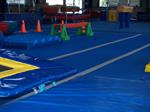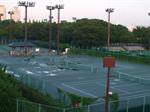Learn to Manage Recreation Facilities

Part 1: A comprehensive introductory course focusing on the management and development or redevelopment of recreation facilities. Subjects cover the nature of recreation and fitness facilities, legal requirements during construction, the management of minor construction projects and evaluating fitness and recreation equipment.
Part 2: This course develops skills to manage day to day operations of facilities such as gyms, health clubs, swimming pools, or recreation facilities. The course deals with managing bookings, purchasing, safety, contingencies and insurance.
Course Structure and Lesson Content:
1. The Scope of Recreation Facility Management
2.  The Nature of Recreation Facility Management
The Nature of Recreation Facility Management
3. Legal Requirements for Construction
-
Introduction
-
Construction
-
Health
-
Special Events
-
Liability and Negligence
-
Minimising Liability
-
Risk Management
4. Planning Construction Work
5. Indoor Equipment
-
Types of Recreation Buildings
-
Indoor Equipment and Facilities
-
General Requirements; access, security, lighting, toilets, parking, signage, staff facilities, etc
-
Needs for Specific Facility Types; swimming centres, community centres, gymnasium, etc
-
Selection Criteria for Equipment
-
Conducting a Cost Analysis
6. Outdoor Equipment
-
Introduction
-
All Purpose Sports Ground
-
Tennis Courts
-
Bowling Club
-
Camp and Caravan Sites
-
Water Recreation; sailing, water skiing, power boating, canoeing, etc
-
Playgrounds
-
Picnic Areas
-
Riding School, etc
7. Safety Procedures
-
Duty of Care; employer, employee, other person, manufacturer.
-
Lifting and Manual Handling
-
Protective Equipment
-
Chemical Handling
-
Protecting Hearing
-
Accidents
-
Safety Risk Analysis
-
Safety Audit
-
Safe Communication
-
Safety Out Doors
-
Water Safety: safety in pools
-
First Aid
-
Safety on Sports Turf
8. Equipment Needs
-
Gym Equipment
-
Types of Equipment
-
Sports Equipment
-
Track and Athletics Equipment
-
Determining Equipment Needs for different sports
-
Tennis
-
Dancing
-
Scouts, Youth Clubs, Other Clubs, Play groups, etc
9. Purchasing
10. Bookings
-
Controlling Facility Use
-
Exclusive Bookings
-
Using Facilities without Prior Bookings
-
Keeping Records of Bookings
-
Procedure for Filing
-
Active and Inactive Records
11. Contingencies
12. Insurance Issues
13. Managing a Recreation Facility
-
Building Maintenance
-
Repairs
-
Bookings
-
Controlling Facility Use
-
Keeping Records
-
Promoting a Facility
-
Managing Aquatic Facilities
-
Toilet and Locker room Facilities
-
Security; security systems, vandalism, ignorant acts, vindictive acts
-
Minimising Vandalism
Here is some of what you may be doing in this course:
- Explain the nature of recreation and fitness facilities.
- Research and explain legal aspects which must be satisfied by construction work projects.
- Assess the suitability of equipment for a given purpose in a recreation or fitness facility.
- Conduct research to find out what recreation facilities services are provided in your locality, and by whom.
- Compare three different facilities in your locality that provide the same type of recreation and fitness services.
- Describe the minimum facilities required to provide common services in different types of recreation facilities, including: *health clubs *gymnasiums *recreation centres *swimming pools *golf clubs *bowling clubs *sporting clubs *sportsgrounds.
TYPES OF RECREATION BUILDINGS
This course is relevant to management of any type of recreation building. There are many different types including:
- Church Halls
- Public Halls
- Town Halls
- Youth clubs/ Scout Halls
- Indoor Swimming Pools
- Health Clubs/Gymnasiums
- Sports Pavilions
Each of these will require a variety of types of recreation and/or leisure equipment to allow projected activities to be carried out.
INDOOR EQUIPMENT/FACILITIES
Management & suitability for a given purpose
There are many different types of indoor recreation facilities, and each, according to its purpose, has the need for specific facilities in order to satisfy its function. The indoor sports centre may provide the nucleus for management of surrounding sports fields, as well as providing a range of general facilities, liaising with a variety of sports organisations such as schools, private clubs and individuals.
GENERAL REQUIREMENTS FOR INDOOR FACILITIES
Access
- This should be controlled preferably by a single, well signed, and easily approached, entry point, but with several, suitable and well signed exits points. The exit points should be located to allow good access back to public transport and/or parking. Often exits will be placed next to or near the main entry, but are separated by barriers of some type.
- Entry can be prevented through exit ways by the use of such means as one way gates or revolving doors, or in the case of facilities with high numbers of users, by manned exits.
- Good, clear, well signed access is also important within the indoor facility. A maze of ill lit, poorly signed passageways, will guarantee that someone will get lost, or delayed, perhaps missing the start of a sporting event.
- Provision should be made for different types of users e.g. disabled, visually impaired, etc. This can often be easily achieved through the provision of ramps instead of, or as well as, steps, the use of suitably placed guide rails, easily accessed disabled parking spaces as close to the entry point as possible.
Security
Good security is very important in any facility. Both users and staff will not wish to use the facility if there is any risk to them of attack or abuse, or if their property/belongings can be readily damaged or stolen. The facility itself requires protection (e.g. vandalism and theft). Generally only large facilities, with a lot of users, can afford to have specialised security staff. It is more common in smaller facilities for other staff (e.g. administration, instructors) to be responsible as part of their general duties, for some degree of security. This may only entail ensuring that locks are securely closed as required; or keeping an eye out for actual or potential trouble involving users, and then informing management or police; or perhaps to step in and act as a mediator or referee to settle arguments. Situations where staff are required to physically manhandle people should be avoided at all costs. In some states (e.g. Victoria) staff who are likely to be placed in such a situation (e.g. bouncers) are required to be licensed and trained.
- Good lighting can play an important part in maintaining a good level of security, both for the users and for the facility itself.
- Surveillance cameras placed carefully can allow staff (e.g. front desk) to keep a watch on potential problem areas, without having to waste a lot of time going backwards and forwards to actually visit those places.
- It may be possible to arrange regular, or even sporadic police drive bys, or visits, particularly if the facility is subject to security problems (e.g. vandalism, teenage "hang out") to help give people a feeling of increased security, and/or to deter anyone who may want to cause trouble.
Lighting
There are three major areas where lighting is important:
- Safety: a well lit (but not over lit) area will reduce the likelihood of accidents occurring, for example, tripping over an uneven surface, or poorly placed object.
- Security
- To provide good visibility for the activities being carried out in the facility. eg. In Australia, a Guide to Sports Lighting has been established by the Standards Association of Australia (AS 2560 - 1982 and later additions).